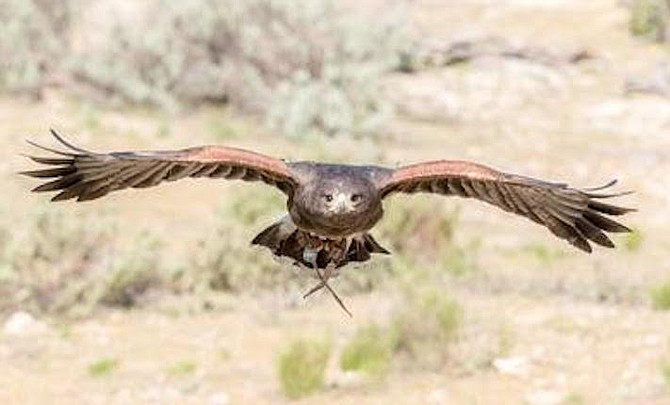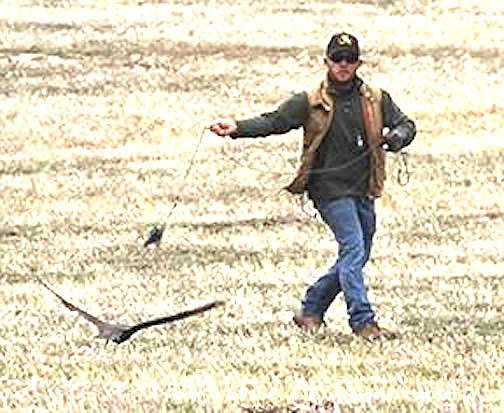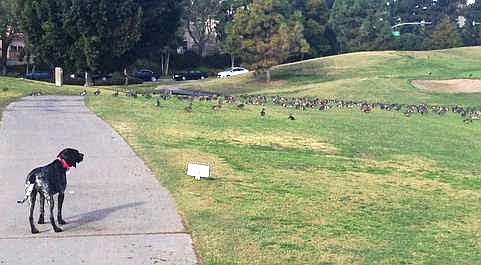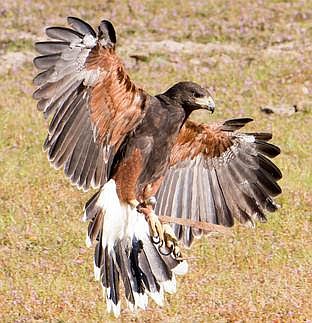
"My falconry services work on bird removal."
"Regarding the pest control industry as a whole, we've seen a spike in calls and workload, particularly in residential areas," said Joshua Crowl of SteadfastFalconry.com. "It's because most of the people are at home, and they see more of those animals at their houses."
On December 28, I spoke with Crowl, a falconer licensed by California Department of Fish and Wildlife who's not your average pest control business owner. He drives a blue and matte black lifted utility truck and rolls with a co-worker that flies over 150 miles per hour.
"Everybody always thinks pest control is about mice and grass and stuff like that. My falconry services work on bird removal, like crows, grackles, blackbirds. They'll get rid of other bird species except, at times, other predatory birds."
"San Diego County .... the unofficial title of "Birdiest County" in the U.S.," says INaturalist.org, "has over 500 birds on the accepted American Birding Association list and many other introduced species. Waters of the Pacific Ocean, mountains over a mile high, and deserts all within the boundaries of the county provide many varied habitats for a broad variety of birds."
Many of the pest birds that Crowl's business abates destroy crops and munch on fruit trees, attack humans and other animals or defecate on fixtures and buildings, which can cost thousands of dollars in repair or lost revenue.

"Crackles and starlings fly in and start picking the seeds out of the grapes."
Take, for example, the vineyards in Valley Center, Escondido, Julian, Ramona, and Valle De Guadalupe south of the border.
"At times, they have crackles and starlings that fly in, and they start picking the seeds out of the grapes," Crowl continued. "So when they picked grapes from the top of the bunch, the juices flow down and destroy that whole bunch, and each one of those bunches is a glass of wine."
On an Escondido and Valley Center online forum, residents talked about the notion of hiring a falconry outfit like Crowl's to abate rabbits, rats, and squirrels devouring their hanging fruit and decimating their gardens in November and December.

"San Diego County has over 500 birds on the accepted American Birding Association list."
"I'd be interested," said Jessica M. "We have a two-acre grove up the top of our property, and we don't poison the squirrels; if they (falconries) would be interested in hunting them, I'd be willing to throw in some [leftover] fruit from our trees. We would have [more] fruit if it weren’t for them darned squirrels. We are out hundreds of persimmons and pomegranates this year thanks to them."
While Crowl commends Jessica for not utilizing poison "because there is secondary poisoning that transfers to other animals," he reiterates that his trained raptors are used primarily for flying-feathered-foes.
"But what about owls?" I asked.
"Owls work, but I don't find them too effective because when we work, we generally work in the day time, and if you see an owl out in the daytime, there's something wrong with it."
Owls reportedly prey on rabbits, raccoons, squirrels, other birds, and skunks.

"When we work, we generally work in the day time."
"So how do you abate rabbits, squirrels, or rats?" I inquired.
"I'll use dogs, and I have a friend that does tracking services. So if someone calls him with a seagull problem, he calls me, and if I see somebody with a raccoon problem, I call him. Our companies help each other out in these situations."
"About how much will it cost?"
"The prices for me to use raptors or dogs will be the same. Some jobs can be like $200, and I'll get some contracts that can go for $100,000. It all depends on what's going on. I can do something for an hour, or I have to hang around the property year-round."
Besides their owl houses, the Valley Center and Escondido dwellers suggested other cost-effective methods to protect their fruits and gardens, including motion sensors connected to water sprinklers, inviting rabbit hunters, the Squirrelinator, chicken wire, and cats.
Peter, who lives by Lake Wohlford, noticed the uptick of varmints. "We see more of them out and about because of the pandemic. Since fewer vehicles are traveling, they are coming out of the woodwork. And since some of us lost our jobs, we can't afford pest control services, and they are multiplying."
“And we aren't doing as much maintenance as we would normally do in some areas,” Crowl corroborated, “the pest population goes up quite a bit.”
"fruit" - Google News
December 30, 2020 at 06:42AM
https://ift.tt/2Md4ViN
San Diego fruit growers use falcons as pest control - San Diego Reader
"fruit" - Google News
https://ift.tt/2pWUrc9
https://ift.tt/3aVawBg
Bagikan Berita Ini














0 Response to "San Diego fruit growers use falcons as pest control - San Diego Reader"
Post a Comment